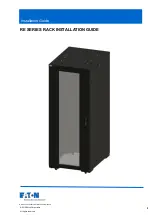
Troubleshooting
E F 3 0 1 5 S e t u p G u i d e ( R e v A )
29
5.2.2
Determine where the fault is occurring
Once you have an understanding of the reported fault, review the enclosure LEDs. The
enclosure LEDs are designed to alert users of any system faults, and might be what alerted
the user to a fault in the first place.
When a fault occurs, the Fault ID status LED on an enclosure’s right ear illuminates (see the
front panel components on page
). Check the LEDs on the back of the enclosure to narrow
the fault to a FRU, connection, or both. The LEDs also help you identify the location of a FRU
reporting a fault.
Use RAIDar to verify any faults found while viewing the LEDs. RAIDar is also a good tool to
use in determining where the fault is occurring, if the LEDs cannot be viewed due to the
location of the system. RAIDar provides you with a visual representation of the system and
where the fault is occurring. It can also provide more detailed information about FRUs, data,
and faults.
5.2.3
Review the event logs
The event logs record all system events. It is very important to review the logs, not only to
identify the fault, but also to search for events that might have caused the fault to occur. For
example, a host could lose connectivity to a virtual disk if a user changes channel settings
without taking the storage resources assigned to it into consideration. In addition, the type
of fault can help you isolate the problem to either hardware or software.
5.2.4
Isolate the fault
Occasionally, it might become necessary to isolate a fault. This is particularly true with data
paths, due to the number of components comprising the data path. For example, if a
host-side data error occurs, it could be caused by any of the components in the data path:
controller module, cable, or data host.
5.2.5
If the enclosure does not initialize
It may take up to two minutes for the enclosures to initialize. If the enclosure does not
initialize:
• Perform a rescan
• Power cycle the system
• Make sure the power cord is properly connected, and check the power source to which
it is connected
• Check the event log for errors
5.2.6
Correcting enclosure IDs
When installing a system with drive enclosures attached, the enclosure IDs might not agree
with the physical cabling order. This is because the controller might have been previously
attached to some of the same enclosures during factory testing,
and it attempts to preserve
the previous enclosure IDs if possible. To correct this condition, make sure that both
controllers are up, and perform a rescan using RAIDar or the CLI. This will reorder the
enclosures, but can take up to two minutes for the enclosure IDs to be corrected.
To perform a rescan using the CLI, type the following command:
rescan
To rescan using RAIDar:
















































